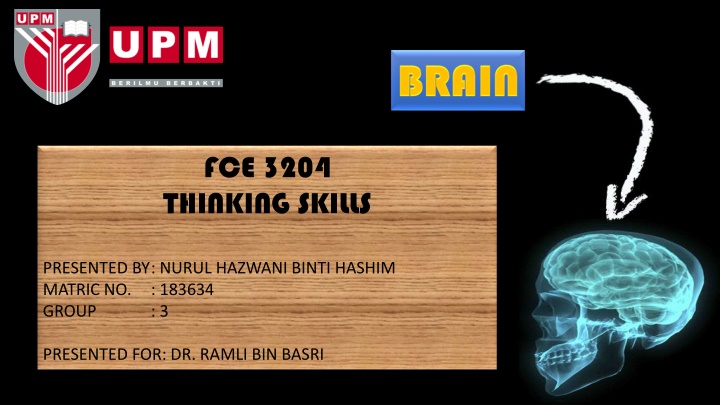
Complexities of the Human Brain
Dive into the intricate world of the human brain, exploring its structure, functions, and communication processes. Discover how neurons facilitate learning and memory, and gain insights into the essential role this powerful organ plays in our everyday lives.
Download Presentation

Please find below an Image/Link to download the presentation.
The content on the website is provided AS IS for your information and personal use only. It may not be sold, licensed, or shared on other websites without obtaining consent from the author. If you encounter any issues during the download, it is possible that the publisher has removed the file from their server.
You are allowed to download the files provided on this website for personal or commercial use, subject to the condition that they are used lawfully. All files are the property of their respective owners.
The content on the website is provided AS IS for your information and personal use only. It may not be sold, licensed, or shared on other websites without obtaining consent from the author.
E N D
Presentation Transcript
FCE 3204 THINKING SKILLS PRESENTED BY : NURUL HAZWANI BINTI HASHIM MATRIC NO. : 183634 GROUP : 3 PRESENTED FOR: DR. RAMLI BIN BASRI
WHAT IS BRAIN ? Most complex organ: a power station that connects every thought, movement and feelings. Contribute 2% of entire body weight Made up 90% water and 10%fat. Made up of more than 100 billion nerves that communicate in trillions of connections called synapses. The brain is one of the largest and most complex organs in the human body. Use 20% of body's energy. Info passed along the neuron through series of chemical message & electric impulse.
FUNCTION PART OF BRAIN PART OF BRAIN FUNCTION CEREBELLUM The base and the back of the brain. The cerebellum is responsible for coordination and balance. PARIETAL LOBE Manage sensation, handwriting, and body position. TEMPORAL LOBE Involved with memory and hearing. OCCIPITAL LOBE Contain the brain's visual processing system. BRAIN STEM Controls functions basic to the survival of all animals, such as heart rate, breathing, digesting foods, and sleeping. Parietal lobe CEREBRUM Temporal lobe Occipital lobe
This is what happen inside the brain itself when brain receive information from other part of body: Nerve cells (neurons) have two main types of branches coming off their cell bodies: Dendrites receive incoming messages from other nerve cells. Axons carry outgoing signals from the cell body to other cells such as a nearby neuron or muscle cell. Interconnected with each other, neurons are able to provide efficient, lightning-fast communication.
A nerve cell (neuron) communicates with other cells through electrical impulses when the nerve cell is stimulated. Within a neuron, the impulse moves to the tip of an axon and causes the release of neurotransmitters, chemicals that act as messengers. Neurotransmitters pass through the synapse, the gap between two nerve cells, and attach to receptors on the receiving cell. This process repeats from neuron to neuron, as the impulse travels to its destination a web of communication that allows you to move, think, feel and communicate.
HOW BRAIN HELPS ME LEARN ? Neurons communicate with each other by sending chemical (neurotransmitters) messages after the body send the signal to the brain. These chemicals cross a gap between neighboring neurons before attaching to their specific receptors. Research suggests, that, at the psychological level, various types of memory are at work in human beings. It also seems increasingly likely when the brain receive different types of exercise that actually stimulates the brain. Types of memory can be classified into: sensory memory, short term memory and long term memory. Sensory Short term Long term Stimulus
SENSORY MEMORY Takes the information provided by the senses and retains it accurately but very briefly. Sensory memory lasts such a short time (from a few hundred milliseconds to one or two seconds) that it is often considered part of the process of perception. Nevertheless, it represents an essential step for storing information in short-term memory. SHORT TERM MEMORY Temporarily records the succession of events in our lives. It may register a face that we see in the street, or a telephone number that we overhear someone giving out, but this information will quickly disappear forever unless we make a conscious effort to retain it. Has a storage capacity of only about seven items and lasts only a few dozen seconds. Just as sensory memory is a necessary step for short-term memory, short-term memory is a necessary step toward the next stage of retention, long-term memory. LONG TERM MEMORY Not only stores all the significant events that mark our lives, it lets us retain the meanings of words and the physical skills that we have learned. Its capacity seems unlimited, and it can last days, months, years, or even an entire lifetime! But it is far from infallible. It sometimes distorts the facts, and it tends to become less reliable as we age.
Recent Brain Research Finding Implications for Learning Increase frequency through practice and maintain fluency through use Frequency of neuron synapses increase memory Appeal to and engage emotions while learning Emotions strengthen memory Learning causes changes to the physical structure of the brain Engaging in learning increases our ability to learn throughout our lives Memories are stored in multiple parts of the brain Engage all senses when learning Learning should tap into the brain s natural curiosity and intrinsic motivation Our brains are programmed to focus on new and unusual inputs
